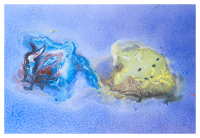Speaker
Jan Hartmann
(Bonn University)
Description
One of the remaining challenges within the standard model is to gain a good understanding of QCD in the low-energy, non-perturbative regime. One key towards this aim is baryon spectroscopy investigating the spectrum and the properties of baryon resonances. Unfortunately, most baryon spectroscopy data were obtained only using $\pi$ N scattering. To gain access to resonances with small $\pi$ N partial width, photoproduction experiments provide essential information. In order to extract the contributing resonances, partial wave analyses need to be performed. Here, a complete experiment is required to unambiguously determine the contributing amplitudes. This involves the measurement of carefully chosen single and double polarization observables.
The Crystal Barrel/TAPS experiment with a longitudinally or transversely polarized target and an energy tagged, linearly or circularly polarized photon beam allows the measurement of a large set of polarization observables. Due to its good energy resolution, high detection efficiency for photons, and the nearly complete solid angle coverage it is ideally suited for the measurement of photoproduction of neutral mesons decaying into photons.
In this talk recent results for various double polarization observables and their impact on the partial wave analysis will be presented.
Supported by DFG within CRC 16
Author
Jan Hartmann
(Bonn University)
